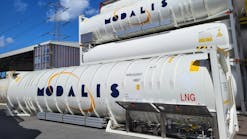NTTC’s Edmondson opens up on tanker industry issues, ways to work together with terminal operators
WHEN tank truck carriers and storage terminal operators meet, it’s typically on the terminal operators’ turf.
Maybe that’s why Dave Edmondson felt comfortable enough to let his guard down in Houston.
Edmondson, the vice-president of safety and compliance at J&M Tank Lines, and national chairman of the National Tank Truck Carriers’ safety and security council, opened up about tank truck driver issues in the session “What Drives the Driver: Understanding Issues in the Tanker Truck Industry” during the International Liquid Terminals Association’s 39th annual International Operating Conference.
The tank truck industry veteran, who started as a driver and still holds a CDL, also shared ideas about how terminal operators can help tanker drivers, and how they can reciprocate.
“Our jobs depend on that truck driver,” Edmondson said. “If he’s not able to get the goods where they need to go, we don’t get a paycheck, because they’re the ones out there earning the money—and generating the revenue for all of us.”
Edmondson started by highlighting NTTC’s mission to serve as the voice of the tank truck industry and a key resource for its leaders, and to champion safety and success in the industry through advocacy and education, including the Zero Distractions campaign the association initiated last year that is aimed at eliminating distracted driving in the motoring public. He also said NTTC is working with tank trailer manufacturers to design better, safer commercial tanks.
“Our biggest push right now is to keep a guy off the top of the tank,” Edmondson said. “How can we spec a tank so a guy doesn’t have to climb on top? And we’re making pretty good headway there.”
Time = money
Edmondson, though he drove a truck up until 2000, doesn’t claim to understand all the inputs that make a truck driver tick, but it’s easy to grasp the greatest motivator for this “unique breed”—time is money.
So anything that costs drivers time is stealing money from their pockets, making it deeply unpopular. Current hinderances to time management include the tricky transition to electronic logging devices (ELDs), inflexibility of the new hours-of-service (HOS) rules, and long delays at terminal facilities.
Trucking companies have been making the switch from automatic on-board recording devices (AOBRDs) to ELDs since at least December 2017, and full compliance with the Federal Motor Carrier Safety Administration (FMCSA) rule, first published four years ago, is coming in December 2019.
But many fleets still are scrambling to meet the new requirement, leaving truckers caught in the middle. “That’s one of the things my company is going through right now, making that transition,” Edmondson said.
NTTC has scored key exemptions from FMCSA’s 30-minute rest-break provision for fuel and hazmat haulers, but drivers still must complete their work in the 14-hour HOS window, which includes 11 hours for driving.
“That 14-hour clock never stops the way the current hours of service are written,” Edmondson said. “That’s something we’re working on. Both NTTC and the American Trucking Associations are working to gain us some flexibility in those hours.”
Long delays for loading and unloading, or sitting around for hours waiting on paperwork, are particularly irksome for truckers, Edmondson said.
“We understand it takes time to load the product, and we understand it takes time to offload the product,” he said. “We, as a company, have factored that into what we charge. So what I’m talking about is what the driver perceives as an unnecessary delay.
“It happens, and I’m not here to (chastise anybody), but when a driver gets delayed like that, we as a company, the shipper and the consignee all are going, ‘Hey, we need you there,’ but he’s put in a hard spot because he’s bound by the hours of service.”
Edmondson said lack of storage is another issue. When a driver reaches a destination only to hear the consignee say they don’t have room for a product, J&M understands, but drivers stop earning money while they wait for space to open—and if they’re not generating income, they’re probably upset.
“(The driver thinks) if they didn’t need it and didn’t have room for it, why’d they order it?” Edmondson said. “He doesn’t see the big picture of, ‘Well, we had a production problem, so we didn’t use what we thought we were going to use.’”
Industry issues
The American Transportation Research Institute’s Critical Issues in the Trucking Industry labeled the driver shortage as the top issue last year, and HOS, driver retention, truck parking, and infrastructure and congestion are high on the list.
A recent Bureau of Labor Statistics article, “Is the US labor market for truck drivers broken?” seems to debunk the mainstream belief that a shortage remains, although Edmondson said he’s skeptical. He is, however, optimistic about greater HOS flexibility coming in the next “six to eight months.”
One NTTC proposal calls for drivers approaching a major city at rush hour be allowed to pull over and stop their HOS clock until traffic clears. “That will take a truck off the road during the highest congestion period, save his hours, make him less stressed, and then when rush hour is over, he can motor on through,” Edmondson said.
Driver retention in the tanker industry is hindered by the extra training required, compared to pulling a van or flatbed trailer, and the need for often-uncomfortable personal protective equipment (PPE).
“Our minimum is hard hat, safety glasses, goggles, boots—that kind of stuff,” Edmondson said. “So, basically, we compound (the problem) by telling a guy, ‘Hey, not only do you have to unload this caustic when you get there, and it’s 95 degrees, I want you to zip yourself up in a big Ziploc bag to do it.’”
Truck parking has been an issue for a while, and it’s only growing worse, Edmondson said. Some truck stops now offer call-ahead parking, and when drivers can’t find a spot, they’re left gambling with HOS.
“One of the biggest things you guys can do to help us—and I know sometimes it’s not an easy thing to do—is give us a place to park,” he said. “When that driver gets there to you, and he’s ready to load but he’s running short on hours, give him a place close by where he can park. If you can’t give him a place to park, give him some suggestions. ‘Hey, there’s a Wal-Mart down the street.’ Anything you can do to help the driver out a little bit.”
As for infrastructure and congestion, Edmondson said simply “It’s brutal out there.” The problem is compounded for tank trailers, which have a higher center of gravity and often are filled with liquid product that sloshes around inside the tank every time the tractor finds a pothole. “It takes an extra toll on the driver, physically and mentally, and it takes an extra toll on the equipment,” Edmondson said.
Tanker specific issues
In addition to the critical issues facing all truck drivers, tank truck fleets face additional costs associated with training, equipment, maintenance and testing.
Extra training includes PPE training, fall protection training and respirator training, to name only a few of the additional requirements, and the Pipeline and Hazardous Materials Safety Administration (PHMSA) requires extensive tank testing, including regular visual and internal inspections.
A plainly spec’ed DOT 407 tank runs $85,000 from most manufacturers, Edmondson said, well-equipped tanks with all the latest bells and whistles, like vapor recovery, and rear or belly unloading, cost as much as $150,000, and highly specialized FRP trailers come with “astronomical” price tags.
The cost of maintaining tankers continues to increase, and they already require extra maintenance due to the nature of the work and average tank age, which is more than twice the industry average.
“If you order a DOT407 tank from any manufacturer in the United States or Canada right now, you’re looking at a minimum of six months before that tank even gets built, so you’re probably looking at seven to eight months before you take delivery of that tank,” Edmondson said.
Working together
Edmondson said NTTC is hoping to work with big petrol companies like Marathon, Shell, Exxon and Mobil to develop a uniform standard, or set of best practices, governing the similar training requirements for all drivers to access their terminals. Then, if a driver is, say, ILTA-certified, he or she can present a card at the facility and gain entrance more quickly by cutting training time in half.
“One of the biggest things that (ILTA) can do for the tank truck industry is come up with all the similarities you have and train to one standard, and then if you have something specific to your site, you can train the driver to that,” Edmondson said.
He’d also like to see NTTC, ATA, ILTA and other associations partner up to form a more unified front on regulatory issues, and create stakeholder committees for input on continuous improvement, and the streamlining of FBI background checks for TWIC and hazmat endorsements.
As for NTTC, Edmondson said the association needs a standard for tank truck drivers that makes it easier for them to move within the industry, and, in response to a question about driver overfills, he said they could do more with remedial training for repeat offenders—even while admitting the driver shortage often has him sending locked-out drivers down the road to the next facility.
“It used to be, when I drove, if you got locked out of someplace, that was it,” he said. “They couldn’t use you anymore. But with the driver shortage the way it is, it’s just a fact of life that, yeah, if he gets locked out of one facility, I’m sending him somewhere else for a few days, and I work around it.”








